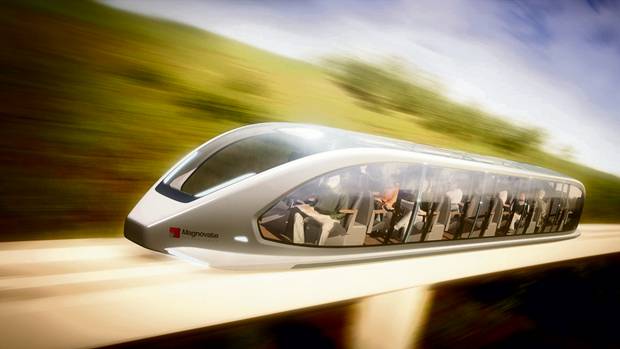When Dan Corns looks to the future of mass transportation, he's confident that his company, Magnovate, will rise above all the noise about shutting down free trade.
"I'm not that worried about NAFTA," says Mr. Corns, whose Edmonton-based company is working on the next generation of magnetic levitation, or maglev, transportation systems.
Dan Corns, head of magnetic levitation transport company Magnovate: ‘I’m not that worried about NAFTA.’
Magnovate
The North American free-trade agreement is under assault as U.S. negotiators make stiff demands on Canada and Mexico, while U.S. President Donald Trump has threatened to pull out of the agreement.
"We're asking two countries [Canada and Mexico] to give up some privileges that they have enjoyed for 22 years. And we're not in a position to offer anything in return," U.S. Commerce Secretary Wilbur Ross said on Oct. 26.
The U.S. NAFTA negotiating team has called for bringing in new requirements that 50 per cent of North American vehicles be made in America, with a 2.5-per-cent tariff to be applied to cars and trucks that don't meet the threshold. The U.S. is also demanding that all North American vehicles have 85 per cent of their content coming from the three NAFTA partners.
The new content requirements would apply only to automobiles, trucks and large parts – not maglev trains or equipment. So while vehicle and auto-parts manufacturers may be under pressure, there is less cause to be anxious in the public transportation sector, Mr. Corns says.
"I don't really think there's going to be a big change in NAFTA as it relates to transportation companies that sell to the public sector," he says.
"Current public policy in the U.S. mandates that 70 per cent of transportation products in this area – such as rail systems – must be built in the U.S. already," he explains.
A lot of Magnovate's work is still in the innovation stage, so the work is being done in Canada.
Magnovate, founded in 2012, is working on a "packet switched" automated maglev system; ultimately it would allow driverless vehicles ranging from five- or six-person shuttles to bus or train-sized cars to arrive on demand along guideways and, using magnets, travel by levitating above the ground.
An artist’s rendering of a group rapid transit vehicle beside a personal express vehicle. Group Rapid Transit vehicles hold 50 passengers; smaller personal express vehicles hold 4-6 passengers.
Magnovate
While maglev technology already exists, Mr. Corns says his company's technology could expand the reach of levitating transportation systems, using infrastructure 70 per cent lighter than existing maglev systems and technology to make the system "smart" so that vehicles go to congested pickup points and bypass empty stations.
In 2014, Magnovate was awarded a contract from Transport Canada to build the first digitally controlled maglev "smart switch" – a tool that he hopes could cut one-hour commutes to as quick as 10 minutes.
An artist’s rendering of the interior of a Magnovate vehicle.
Magnovate
Magnovate is working on a pilot project at the Toronto Zoo and gets support from Toronto's MaRS Discovery District, which works with technology startups. Ultimately, Mr. Corns and his company of about 17 people are setting their sights on exporting their technology to the United States and international markets.
Going into the United States would require putting down roots there regardless of how the NAFTA negotiations turn out, he says. "Most companies in the public transportation sector set up plants there."
It will be a new situation for the entire transportation sector if the United States sticks to its demands on content, says Bernard Wolf, professor emeritus of economics and international business at York University's Schulich School of Business.
"I really don't think that [the U.S. position] is going to fly, and if it doesn't, the agreement will die and we'll be in a whole different ball game," Dr. Wolf says.
The difficulties will emerge if NAFTA dies and the 2.5-per-cent tariff is imposed. When vehicles are assembled parts can cross both the Canadian and Mexican borders multiple times. "Will you have to pay a tariff every time? It's unclear," Dr. Wolf says.
Even amid the uncertainty, parts makers in Canada remain optimistic that a reasonable free-trade deal with the United States will survive.
The transportation sector is much bigger and more diverse than car and truck manufacturers anyway. It includes everything from parts company giants, such as Magna International Inc., to builders of lithium batteries for electric vehicles, to forward-thinking public transit companies, such as Magnovate.
As Mr. Corns points out, different types of transportation-related companies operate under different rules under NAFTA already and will likely continue to do so.
In early October, Magna joined a consortium that includes BMW and Intel Corp. to develop new technology aimed at putting self-driving vehicles on the road by about 2021. The alliance includes a company that Intel purchased called Mobileye, a supplier of auto-collision detection technology.
These kinds of multicountry alliances, which travel back and forth across borders with ideas as well as goods and services, bode well for Canada's transportation sector on the whole, Mr. Corns says. While the American market is still critically important for Canadian transportation companies, it's not the only one.
A mockup of a station interior.
Magnovate
"For a company like Magnovate that's bringing technology from the lab to the commercial marketplace, the big opportunities are in Asia and the Middle East," he says.
"We're concentrating on exporting to China and to places like Saudi Arabia and the United Arab Emirates."
In addition, Mr. Corns adds, there's no place like home.
"There are projects in our own backyard that we're pursuing. I'm quite happy focusing on building in Canada," he says.
MORE FROM THE SERIES:
An artist’s rendering of an urban network that includes maglev vehicles that range from personal to group rapid transit vehicles, and an e-commerce freight vehicle.
Magnovate

